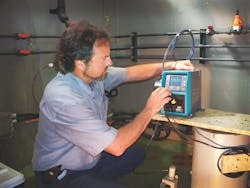A Search for Safety With Chemical Feed Pumps
About the author:
Russell Merritt is marketing manager for Watson-Marlow Pumps Group. Merritt can be reached at [email protected] or 800.282.8823.
When Veolia Water needed to replace an aging mechanical diaphragm pump for a chemical application at its Simcoe Wastewater Treatment Plant (WWTP), the company decided to make a switch to new no-valve metering pump technology. Seeking to take advantage of precise chemical metering, safer chemical handling, ease of maintenance and low cost of ownership, Veolia selected a new type of drop-in replacement metering pump supplied by Watson-Marlow Pumps.
Chemical Feed Pumping Solutions
Veolia’s Simcoe WWTP in Norfolk County, Ontario, Canada, runs a variety of pumps for its chemical feed operations, including sodium hypochlorite and sodium bisulfite, and was about to initiate a new ferrous chloride application. Ferrous chloride is used to help with coagulation and phosphorus removal. The plant’s existing mechanical diaphragm pump was aging, and Simcoe Plant Manager Roger Wilkes was looking at a variety of pumps that would offer better flow, more consistent chemical handling, and the ability to make daily chemical dosage adjustments according to the phosphorous levels present. The plant also was looking for the safest possible way to handle the chemical.
The properties of ferrous chloride also spurred plant operators to consider ease of maintenance when selecting a new pump, because handling the chemical during maintenance could pose an operator safety concern.
William Luisser, technical sales representative for Metcon Sales & Eng. Ltd., and James Keenan, Canadian sales manager for Watson-Marlow, suggested that the Simcoe WWTP might be a good candidate for Watson-Marlow’s new Qdos 30 metering pump, a lower-pressure pump designed for typical wastewater flow. The new technology is designed for flow rates of 0.1 to 500 mL per minute (0.001 to 8 gal per hour) at 7 bar (100 psi) continuous duty.
The fully sealed pumphead technology was one of the key features that attracted Veolia to the pump for this application. Any chemicals being pumped are contained in the pumphead housing, ensuring operator safety and ease of maintenance.
The single-sealed pumphead component is the only part requiring replacement. Wilkes especially appreciated the fact that replacement was simple, with no need for special tools, no requirement for specialist training and no need for skilled maintenance technicians.
According to Keenan, the pump can be reversed for maintenance. “You can take liquid out of the line to work on it without the fear of having any chemicals leaking. The Qdos 30 pump gives both a visual and electronic indication when the ReNu pumphead must be replaced,” he said.
Luisser pointed to the easy-to-use full-color thin-film-transistor LCD, which gives Simcoe plant operators a great view of performance details. The WWTP selected the universal control option; other available choices are manual control only; automatic with full analog speed control and feedback, relay outputs and SCADA level inputs; and a Profibus network control version.
The metering pump also eliminated the need for downstream ancillary equipment, like backpressure valves, pulsation dampeners, strainers and float switches. The pump can work with fluids that contain solids, and the only equipment needed was an upstream screen to keep larger debris and particles out. This reduced both the equipment and ongoing maintenance costs associated with chemical metering. “These ancillary devices cost a fair amount,” Keenan said. “You are saving money when you only have to buy a pump and very little else.”
Smooth Operation
Since installing the new technology, operators at the facility have been impressed with how simple it is to run and maintain. Whereas the mechanical diaphragm pump resulted in an hour and a half of downtime, the new metering pump technology takes far less time. The pump also uses the same pumphead on all chemicals, cutting back significantly on the need to maintain a large inventory of parts for different chemical metering applications. Diaphragm pumps may require different diaphragm kits, depending on the chemical.
Wilkes noted that the pump is operating well. It is easier to attach to the existing chemical line, and adjustment is simple with the user interface, which allows operators to program accurate and repeatable flow rates that correspond to actual process conditions. He also reported that the head lasts a relatively long time, especially considering that it receives fine particulates in the form of metal shavings from a steel mill. Wilkes can expect about six months of life from the ReNu pumphead, with the pump working 24/7. Changing the pumphead is far quicker and easier than changing the mechanical diaphragm pump.
“The Qdos 30 is a well-priced pump that fits our budget and gives me a good bang for the buck. It works very well for our application, and I’ve gotten excellent feedback from the plant operators,” Wilkes said.
As a result, Veolia is now actively looking at switching other processes to the Qdos 30 at three additional facilities. Wilkes recently placed an order for six more pumps for additional chemical applications.
Download: Here
